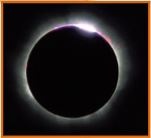Kurzbeschreibung
During this activity, the children visualise a solar eclipse using a setup of Sun, Earth, and Moon models. This phenomenon was correctly explained for the first time by the Greek philosopher Anaxagoras in 500 BCE.
 Fig. 6 Total solar eclipse (Credits: wikipedia.en)
Fig. 6 Total solar eclipse (Credits: wikipedia.en)
Before going through the activity, read the story attached:
Ziele
Using simple items, the children simulate the Sun-Earth-Moon system to understand how a solar eclipse works. They also develop an appreciation for the achievements of ancient Greek philosophers who were successful in deriving the correct explanation for this phenomenon. This simulation reinforces the children’s skill of attaining different perspectives of observation.
Lernziele
After carrying out this activity, the children will be able to:
- explain how solar eclipses work.
- name the ancient Greek philosopher who derived the correct explanation for this astronomical phenomenon.
Bewertung
Ask the children the following questions:
- Before 500 BCE, what did people think happened when a solar eclipse took place?
- Who managed to explain correctly what really happens during a solar eclipse?
- Take the Earthball/globe, the flashlight and the Moon-model and place the Moon-model such that Anaxagoras experiences a solar eclipse. Does he become afraid? Why not?
Materialien
- A flashlight or lamp
- A UNAWE Earthball or globe
- A model of the Moon, for example a Styrofoam ball
- A paper figure of Anaxagoras, to be placed on the Earthball
Hintergrundinformationen
Since the dawn of history, people all around the world became very scared each time the sunlight vanished during day time. Most of them thought that this was a divine punishment. In 500 BCE, and 100 years after Thales, another Greek natural philosopher called Anaxagoras, born in the city of Clazomenae (today´s Turkey), searched for other explanations for astronomical phenomena. He succeeded in finding the cause of solar eclipses and was the first to bring natural philosophy to Athens. He understood that when the Sun, the Moon and the Earth are perfectly aligned and the Moon is located between the Sun and the Earth (new moon phase) the Moon “covers” the Sun in the sky, subsequently projecting a shadow on the Earth. During a total solar eclipse the area under this shadow become dark for several minutes.
Vollständige Beschreibung der Aktivität
Switch on the flashlight or lamp and place the model of the Moon and the Earthball in the order shown in figure 7: the Moon-model should be placed at position 3 (new moon phase see fig. 4) in such a way that the shadow of the Moon hits the Earthball/globe. When the figure of Anaxagoras is placed on the Earthball/globe in the shadow area, the children will notice that despite being on the dayside of the Earth, Anaxagoras will find himself in the darkness for a while. As the Moon continues its orbit around the Earth, the Sun will shine again upon Anaxagoras!
 Full solar eclipse (Credits: Scorza/Provot)
Full solar eclipse (Credits: Scorza/Provot)
Lehrplan
Space Awareness curricula topics (EU and South Africa)
The journey of ideas, Solar system
Fazit
With this activity, the children will learn and realise by experiment how solar eclipses work. This is ancient knowledge that was found out around 500 BCE.


